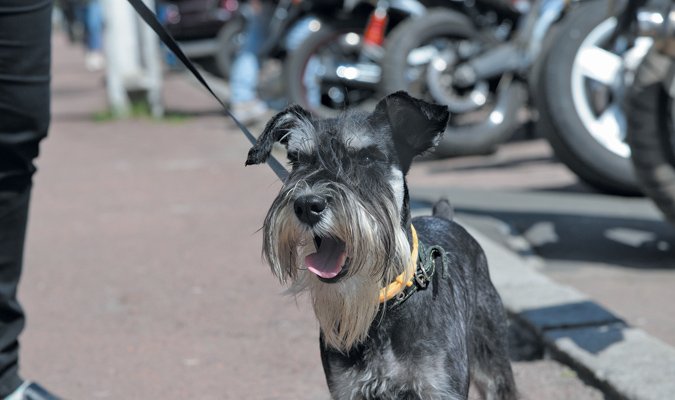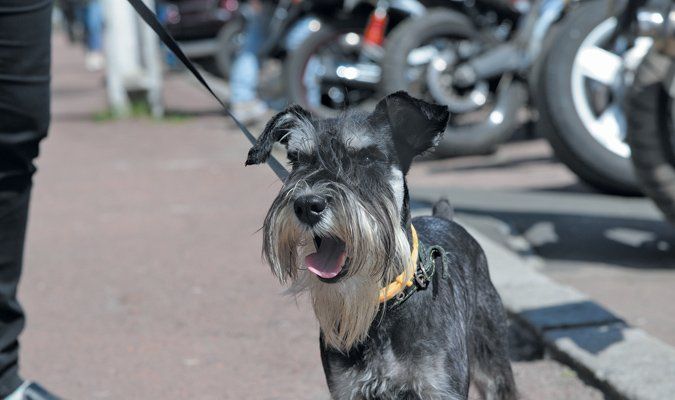

© osobystist | Bigstock
“Imagine if we had to greet people by slapping them in the face, or by swearing at them before we said hello. It would get things off on the wrong foot,” says the head of the Tufts Animal Behavior Clinic, Stephanie Borns-Weil, DVM, “and that’s how it is for dogs on leashes. Meeting on leash is not natural for dogs. On their own, they approach each other tentatively, in a wide arc from the side. They evaluate the other dog’s body language and determine whether to come forward or retreat. But on leash they’re forced to come face to face — with other dogs, with people. It’s considered impolite in the canine world to approach too head-on. And for some dogs that are fearful, the head-on greeting may trigger aggression. They can’t get away — they’re tethered to you, after all — so they feel they have no other choice. They need to guard their perimeter. It’s a very common problem that I work with.”
Dogs owners often respond by saying their pet needs to be socialized more, exposed to more situations involving leashes. But efforts to desensitize dogs that are fearful or aggressive on leash by forcing them into the situation won’t work.
Training your dog out of leash reactivity
It’s almost impossible to desensitize a dog out of leash aggression. Desensitization tends to occur one dog, or one person, at a time, but if you live in a suburb or an urban area, your dog is coming across too many other dogs and too many other people while on leash to be able to calm down. “It’s called trigger stacking,” Dr. Borns-Weil says. “They may be okay with the first dog or two, or the first couple of people, but by the third or fourth encounter, they can’t recover anymore, and the aggression takes off.”
There is a reason they are reacting this way. “They feel as if they’ve been parachuted into a suburban or urban war zone where danger is everywhere,” Dr. Borns-Weil says.
Your role is not to try to desensitize them but to teach them an alternative behavior — something that’s incompatible with barking at another dog and lunging at it, that helps them move past the other dog without incident. “You want to get your dog to learn that a strategic retreat is better than turning aggressive,” the doctor says.
How? Dr. Borns-Weil points out that for most dogs, there’s a threshold, a distance, at which the unfortunate behavior starts. For some dogs, it’s “across the street.” For others, it’s “100 yards away.” Whatever your dog’s threshold, start there. When your dog is on leash and in the vicinity of another dog but doesn’t go off half-cocked, reward her with praise and a delicious treat. The substitution for her aggressive behavior is looking at you and receiving something desirable while you keep moving.
Start the reward process even when your dog doesn’t react to another dog that is quite far off. You might think your dog simply doesn’t notice the other dog, but that’s not the case, Dr. Borns-Weil says. “A dog on leash who has her guard up is hypervigilant. It’s simply that the other dog hasn’t gotten close enough to trigger aggression; she thinks she may escape an interaction with that dog.”
Little by little, over a long, slow process, your dog will be able to let other dogs come a little closer without reacting. The trigger distance will start to shrink because she is getting the hang of the fact that seeing another dog while she’s on leash means there’s something good in it for her if she can contain herself: food and a guarantee that you will protect her by moving her away from the danger. “What often happens after a while,” Dr. Borns-Weil says, “is that when your dog is on leash and sees another dog, she will look at you rather than go into attack mode. She’s waiting for your words of praise and her mini-snack.”
This is a much more achievable goal than getting your dog to be friends with all other dogs, or all other people, which is not necessary. The aim is simply to teach your pet to ignore and be ignored. Over time, she may calm down to the point that she can enjoy being around other living things that want to pay attention to her when she’s on leash. But if not, that’s okay, too.
When Your Dog Must Pass Another Dog While on Leash
Sometimes you are not in a position to keep your dog on leash away from an approaching dog or person. In such cases, Dr. Borns-Weil advises, it’s good to keep your reactive dog in a harness rather than just a neck collar. Then, with just a gentle movement, you can move your pet along. “The harness I like best is the Freedom No-Pull Harness with Double Leash,” the doctor says. “It gives the most control without causing any stress to the dog.
“For dogs who are really pulling, jumping, and twisting,” she adds, “I will use the harness and a head halter. When your dog is lunging, you can hold her back with the harness and use the head halter to very gently turn or move her away.” Your dog will actually feel safer being turned from what she perceives as danger rather than trying to take care of herself. She needs to know you’re in her corner.
A Separate Peace
A lot of people try to force their leashed dogs into being friendly with other dogs and their owners, thinking that they are to blame for their dog’s behavior. Others may blame them, too. But they are not culpable. A scared dog on leash is afraid because she is afraid, not because her owner somehow transmitted the fear.
“People deserve positive feedback for sticking it out with a reactive dog,” Dr. Borns-Weil says, “not negative feedback. And owners should not feel pressured to throw their dogs into situations that make their pets uncomfortable.”
Indeed, it’s okay for dog owners to stick up for their anxious dogs, the doctor says. “A legitimate response to ‘Can I pet your dog?’ is ‘No, she’s fearful of people while on leash.’ It’s also okay to put warning gear such as a vest or neck scarf on her that says ‘Fearful, give me space.'” The aim is to make your pet feel secure by discouraging other people from invading her comfort zone.





